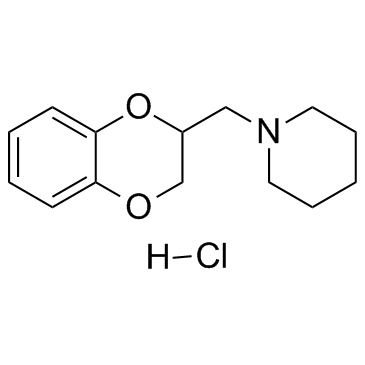CHEMICAL IDENTIFICATION
-
RTECS NUMBER :
-
TM4550000
-
CHEMICAL NAME :
-
Piperidine, 1-(1,4-benzodioxan-2-ylmethyl)-, hydrochloride
-
CAS REGISTRY NUMBER :
-
135-87-5
-
LAST UPDATED :
-
199509
-
DATA ITEMS CITED :
-
6
-
MOLECULAR FORMULA :
-
C14-H19-N-O2.Cl-H
-
MOLECULAR WEIGHT :
-
269.80
-
WISWESSER LINE NOTATION :
-
T66 BO EOT&J C1- AT6NTJ &GH
HEALTH HAZARD DATA
ACUTE TOXICITY DATA
-
TYPE OF TEST :
-
LD50 - Lethal dose, 50 percent kill
-
ROUTE OF EXPOSURE :
-
Oral
-
SPECIES OBSERVED :
-
Rodent - mouse
-
DOSE/DURATION :
-
502 mg/kg
-
TOXIC EFFECTS :
-
Behavioral - tremor Behavioral - convulsions or effect on seizure threshold Behavioral - excitement
-
REFERENCE :
-
JAPMA8 Journal of the American Pharmaceutical Association, Scientific Edition. (Washington, DC) V.29-49, 1940-60. For publisher information, see JPMSAE. Volume(issue)/page/year: 48,409,1959
-
TYPE OF TEST :
-
LD50 - Lethal dose, 50 percent kill
-
ROUTE OF EXPOSURE :
-
Intraperitoneal
-
SPECIES OBSERVED :
-
Rodent - mouse
-
DOSE/DURATION :
-
175 mg/kg
-
TOXIC EFFECTS :
-
Behavioral - tremor Behavioral - convulsions or effect on seizure threshold Behavioral - excitement
-
REFERENCE :
-
JAPMA8 Journal of the American Pharmaceutical Association, Scientific Edition. (Washington, DC) V.29-49, 1940-60. For publisher information, see JPMSAE. Volume(issue)/page/year: 48,409,1959
-
TYPE OF TEST :
-
LD50 - Lethal dose, 50 percent kill
-
ROUTE OF EXPOSURE :
-
Subcutaneous
-
SPECIES OBSERVED :
-
Rodent - mouse
-
DOSE/DURATION :
-
500 mg/kg
-
TOXIC EFFECTS :
-
Behavioral - analgesia
-
REFERENCE :
-
THERAP Therapie. (Doin, Editeurs, 8, Place de l'Odeon, F-75006 Paris, France) V.1- 1946- Volume(issue)/page/year: 13,17,1958
-
TYPE OF TEST :
-
LD50 - Lethal dose, 50 percent kill
-
ROUTE OF EXPOSURE :
-
Intravenous
-
SPECIES OBSERVED :
-
Rodent - mouse
-
DOSE/DURATION :
-
26 mg/kg
-
TOXIC EFFECTS :
-
Details of toxic effects not reported other than lethal dose value
-
REFERENCE :
-
AIPTAK Archives Internationales de Pharmacodynamie et de Therapie. (Heymans Institute of Pharmacology, De Pintelaan 185, B-9000 Ghent, Belgium) V.4- 1898- Volume(issue)/page/year: 105,221,1956 ** REPRODUCTIVE DATA **
-
TYPE OF TEST :
-
TDLo - Lowest published toxic dose
-
ROUTE OF EXPOSURE :
-
Oral
-
DOSE :
-
735 mg/kg
-
SEX/DURATION :
-
female 3-9 day(s) after conception
-
TOXIC EFFECTS :
-
Reproductive - Fertility - pre-implantation mortality (e.g. reduction in number of implants per female; total number of implants per corpora lutea)
-
REFERENCE :
-
PSEBAA Proceedings of the Society for Experimental Biology and Medicine. (Academic Press, Inc., 1 E. First St., Duluth, MN 55802) V.1- 1903/04- Volume(issue)/page/year: 100,555,1959
-
TYPE OF TEST :
-
TDLo - Lowest published toxic dose
-
ROUTE OF EXPOSURE :
-
Intramuscular
-
DOSE :
-
250 mg/kg
-
SEX/DURATION :
-
female 5 day(s) after conception
-
TOXIC EFFECTS :
-
Reproductive - Fertility - pre-implantation mortality (e.g. reduction in number of implants per female; total number of implants per corpora lutea)
-
REFERENCE :
-
PSEBAA Proceedings of the Society for Experimental Biology and Medicine. (Academic Press, Inc., 1 E. First St., Duluth, MN 55802) V.1- 1903/04- Volume(issue)/page/year: 100,555,1959
|
